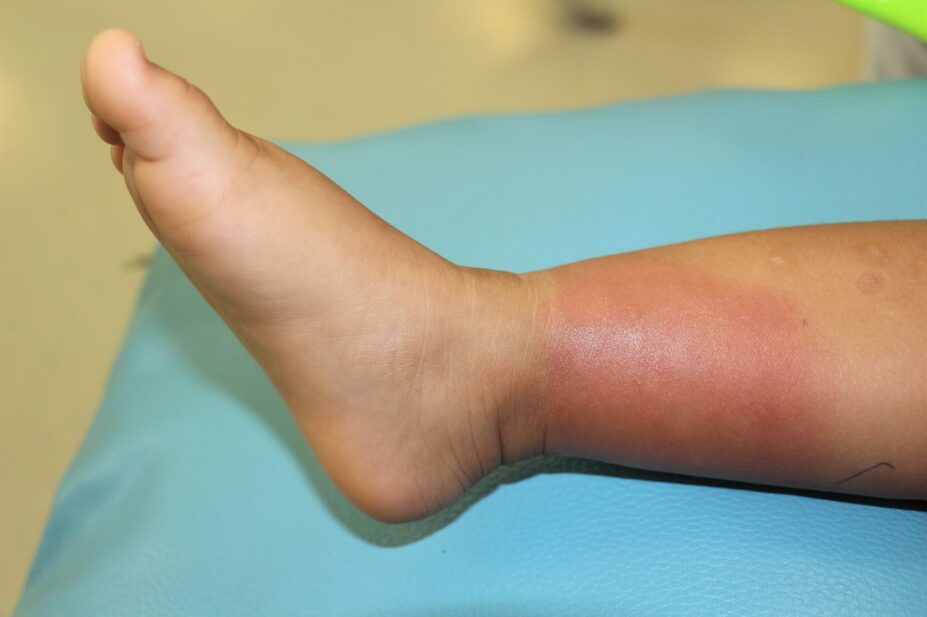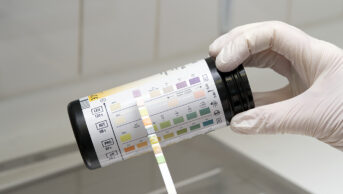
Shutterstock.com
By the end of this article, you should be able to:
- Understand the diagnostic basis of sepsis and how to use of sepsis screening and risk stratification tools;
- Know which patient groups are more vulnerable to developing sepsis;
- Know how sepsis management differs for high- and moderate-risk patients;
- Understand how antimicrobial stewardship can be optimised for sepsis patients.
In the UK, sepsis is estimated to cause around 48,000 deaths per year and 40% of sepsis survivors suffer life-changing effects1. Sepsis is among the most common causes of hospital inpatient deterioration, affecting hundreds of millions of patients worldwide each year2. Sepsis is caused by the patient’s abnormal response to an infection1. The infection triggers a dysregulated cascade of immune responses resulting in inflammation and damage to organs. If sepsis is not recognised and treated efficiently patients can deteriorate quickly, progressing to severe sepsis and septic shock. Septic shock is the most severe form of sepsis, patients require intensive care treatment and organ support, and have a high risk of death3.
Pharmacists and pharmacy technicians working in all clinical settings will encounter patients who are at risk of sepsis; those working in secondary care may be involved in identification of the condition and the ongoing care of patients with sepsis. As a result, it is important for pharmacists and pharmacy technicians to recognise sepsis and know how to respond to it.
Efforts to identify and treat patients with suspected sepsis at the earliest opportunity have come into conflict with efforts to improve antimicrobial stewardship. For many years, national quality improvement initiatives have included the recommendation that broad spectrum antimicrobials be administered within one hour of presentation4. These initiatives and campaigns such as ‘Surviving sepsis’ have resulted in policy and guidelines directing the early use of broad-spectrum antibiotics despite the supporting evidence for their effectiveness being weak5. There have been efforts to address the imbalance, most notably by the Academy of Medical Royal Colleges6.
The National Institute for Health and Care Excellence (NICE) has recently updated its suspected sepsis guideline, endorsing a more measured approach to the administration of antibiotics depending on risk of severe disease or death7.
This article will cover the management of suspected sepsis, from diagnosis and identifying the source of infection, through to pharmacological management and patient prognosis. ‘Case-based learning: recognising sepsis‘ provides a further overview of the signs and symptoms of sepsis8.
Diagnosis of sepsis
Risk stratification
There is no single test, sign or symptom that can be used to diagnose sepsis. Instead, diagnosis is based on clinical assessment, the use of sepsis screening and risk stratification tools1.
Each patient with suspected sepsis must undergo a comprehensive review of their current physical state, signs and symptoms of infection, ‘National Early Warning Score 2’ (NEWS2) score and a thorough review of their medical history, including age, underlying physiology, comorbidities and drug history7,9. This information allows the clinician to formulate a risk assessment to predict the risk of severe illness or death from sepsis to the patient.
NEWS2 is a simple scoring system that considers six physiological parameters:
- Respiration rate;
- Oxygen saturation;
- Systolic blood pressure;
- Pulse/heart rate;
- Level of consciousness or new confusion;
- Temperature9.
A score is attributed to each parameter, the size of the score differs depending on how far from the normal is recorded for each parameter, and then two points are added to the score for people needing supplemental oxygen to maintain oxygen saturations. The score for each parameter is added together to produce a final score.
A score of five or greater in a patient with infection identifies patients that might have sepsis and therefore require further diagnostic assessment9.
Increased C-reactive protein (CRP) may also indicate an infection or inflammation but decision making should be based on the patient’s symptoms — do not base decisions on inflammatory markers alone10.
Identifying the source of infection
Identifying the source of sepsis is essential to ensure that a patient receives optimal treatment and management of their infection. Evidence suggests that patients have poorer outcomes if the source of sepsis is not identified11.
The most common sources of infection in patients presenting with sepsis are the lung, abdomen and urinary tract12.
Diagnostic options in an acute scenario that can be used to support the identification of the source of infection can be seen in Table 2.
People who are most vulnerable to sepsis
Some groups of people are more vulnerable to developing sepsis than others, this includes very young children (aged under 1 year old), older people (aged over 75 years old), people who are pregnant or have given birth within the past six weeks, and people who have an impaired immune system7. NICE has produced individual risk assessment criteria for these specific groups.
Children
Risk stratification varies depending on the age of the child, for example the behaviour category included in high risk in children aged under 5 years old is different to the behaviours of children aged 5-11 years. Physiological parameters, such as respiratory rate and heart rate, also vary dependent of the age of the child, acknowledging that children aged under 5 years old have higher resting respiratory and heart rates for their age than older children7.
Pregnancy
People who are pregnant, who have given birth or had a termination of pregnancy or miscarriage within the past six weeks are at higher risk for developing sepsis, especially if they have any comorbidities or pregnancy complications, such as diabetes, immune suppression, complicated delivery (e.g. prolonged membrane rupture, invasive procedure including forceps, caesarean section)7.
Management of sepsis
High-risk patients
Patients who are assessed as high risk should be escalated as ‘RED FLAG SEPSIS’ and should follow the ‘Sepsis Six’ pathway, a set of six tasks developed by the UK Sepsis Trust, including oxygen, cultures, antibiotics, fluids, lactate measurement and urine output monitoring to be instituted within one hour by non-specialist practitioners on the frontline (see Table 313–15).
Delivery of the Sepsis Six ‘care bundle’ within an hour of sepsis recognition has been shown to reduce the relative risk of death by 46.6%13.
For patients assessed as moderate-risk under the NICE risk criteria:
- Send full set of bloods including venous blood gases;
- Consider discussing with senior decision-maker;
- Administer antimicrobials within three hours, if indicated;
- Reassess if patient deteriorates or situation changes1.
Antimicrobial management
Owing to the urgency of treatment and the non-specific nature of sepsis presentation, it can be difficult to diagnose the source of sepsis in the initial acute phase. Bacterial infections are the most common cause of sepsis, with gram-negative infections more prevalent than gram-positive infections12. Therefore, initial empiric antimicrobial treatment should be with a regimen that will provide broad spectrum cover and good circulating concentrations and tissue penetration, to be guided by local empiric treatment guidelines (see Box).
Box: Examples of empiric treatment regimens used for sepsis of unknown origin in the UK include*:
- Co-amoxiclav + gentamicin;
- Ceftriaxone + metronidazole + gentamicin (suitable for patients with a mild penicillin allergy);
- Levofloxacin + metronidazole + gentamicin (suitable for patients with a severe penicillin allergy).
*These are examples of regimens from UK hospitals. Guidelines should be informed by local surveillance; for example, amikacin may be used as an alternative in areas where there is high rates of gentamicin in gram-negative organisms.
IV antibiotics are essential in the acute phase to ensure adequate concentrations at the site of infection; however, once clinically stable patients should be assessed for suitability for an IV to oral switch as per national guidance16.
Once the source of infection is clear, antimicrobial choice, dosage and course length should be based on local antimicrobial guidance while considering patient related factors7 (see Table 417,18).
Not all infections can be managed by antimicrobial treatment alone — if the infection has an underlying deep source, source control should be considered. Surgical teams should be consulted regarding surgical or radiological interventions7.
Escalation of antimicrobial treatment
Some patients may not respond well to the initial choice of antimicrobial treatment; however, there can be a tendency for rapid escalation and clinicians must ensure they have allowed sufficient time for antimicrobials to have an effect. Treatment escalation should be considered if microbiological samples indicate resistance. If a patient fails to respond within one hour of an intervention, they should be re-assessed by a senior decision-maker7.
Patient prognosis
According to the UK Sepsis Trust, the mortality rate from sepsis is estimated at around 20%, with sepsis claiming more lives than lung cancer1. Factors associated with poor prognosis in sepsis can be seen in Table 56,19.
Conclusion
If sepsis is not recognised and managed with a timely, structured approach, the consequences can be devastating for patients and their families. Work by organisations such as the UK Sepsis Trust to raise awareness of sepsis for healthcare professionals and the general public can save lives and improve outcomes.
Pharmacists play an important role in the management of sepsis, optimising diagnostics and the use of antimicrobials, and being an advocate for antimicrobial stewardship in the acute care setting. The sepsis and antimicrobial stewardship agendas often appear at odds with each other. NICE’s updated sepsis guideline also provides an important balance between optimising outcomes in patients with sepsis and improving antimicrobial stewardship7.
Best practice
- Ensure antimicrobials prescribed follow good practice on antimicrobial stewardship20;
- Antimicrobial choices should be based on local antimicrobial guidelines and consider previous antimicrobial resistance;
- Blood cultures should ideally be done before antibiotics are given to identify primary bacteraemia7;
- Patients have the right to be involved in decision making regarding their care and, where possible, patients with sepsis should be involved in discussions and be given appropriate information about their management, including the risks and benefits of treatment21;
- Patients should be followed up once sepsis has been diagnosed; this includes counselling the patient and their carers/ family about sepsis, recovery and any additional care or further investigation required;
- Patients should be assessed for complications and referred to relevant specialists for further management. For example, symptoms of anxiety and/or post-traumatic disorder to be referred to mental health team.
- 1.References and sources . UK Sepsis Trust. Accessed July 2024. https://sepsistrust.org/about/about-sepsis/references-and-sources/
- 2.Sepsis key facts. World Health Organization. Published May 2024. Accessed July 2024. https://www.who.int/news-room/fact-sheets/detail/sepsis#:~:text=Healthcare%20associated%20infections%20are%20caused,to%20sepsis%20and%20septic%20shock
- 3.Sepsis and septic shock. Sepsis Alliance. Published 2024. Accessed July 2024. https://www.sepsis.org/sepsisand/septic-shock/
- 4.Ingham Clark C. Tackling Sepsis and Saving lives. NHS England. Published 2019. Accessed July 2024. https://www.england.nhs.uk/blog/tackling-sepsis-and-saving-lives
- 5.Surviving Sepsis Campaign. Society of Critical Care Medicine. Accessed July 2024. https://www.sccm.org/SurvivingSepsisCampaign/Home
- 6.Statement on the initial antimicrobial treatment of sepsis. Academy of Medical Royal Colleges. Published October 2022. Accessed July 2024. https://www.aomrc.org.uk/wp-content/uploads/2022/10/Statement_on_the_initial_antimicrobial_treatment_of_sepsis_V2_1022.pdf
- 7.Suspected sepsis: recognition, diagnosis and early management [NG51]. National Institute for Health and Care Excellence . Published March 2024. Accessed July 2024. https://www.nice.org.uk/guidance/ng51
- 8.Case-based learning: recognising sepsis. Pharmaceutical Journal. Published online 2019. doi:10.1211/pj.2019.20207107
- 9.National Early Warning Score (NEWS) 2: Standardising the assessment of acute-illness severity in the NHS. Royal College of Physicians. Published 2017. Accessed July 2024. https://www.rcplondon.ac.uk/projects/outputs/national-early-warning-score-news-2
- 10.Escadafal C, Incardona S, Fernandez-Carballo BL, Dittrich S. The good and the bad: using C reactive protein to distinguish bacterial from non-bacterial infection among febrile patients in low-resource settings. BMJ Glob Health. 2020;5(5):e002396. doi:10.1136/bmjgh-2020-002396
- 11.Ling L, Mui OOY, Laupland KB, et al. Scoping review on diagnostic criteria and investigative approach in sepsis of unknown origin in critically ill patients. j intensive care. 2022;10(1). doi:10.1186/s40560-022-00633-4
- 12.Niederman MS, Baron RM, Bouadma L, et al. Initial antimicrobial management of sepsis. Crit Care. 2021;25(1). doi:10.1186/s13054-021-03736-w
- 13.Sepsis. NHS England. Accessed July 2024. https://www.england.nhs.uk/ourwork/clinical-policy/sepsis/
- 14.Lee SM, An WS. New clinical criteria for septic shock: serum lactate level as new emerging vital sign. J Thorac Dis. 2016;8(7):1388-1390. doi:10.21037/jtd.2016.05.55
- 15.Im Y, Kang D, Ko RE, et al. Time-to-antibiotics and clinical outcomes in patients with sepsis and septic shock: a prospective nationwide multicenter cohort study. Crit Care. 2022;26(1). doi:10.1186/s13054-021-03883-0
- 16.National antimicrobial intravenous to oral switch criteria for early switch. UKHSA. Published February 2023. Accessed July 2024. https://www.gov.uk/government/publications/antimicrobial-intravenous-to-oral-switch-criteria-for-early-switch/national-antimicrobial-intravenous-to-oral-switch-ivos-criteria-for-early-switch
- 17.Martínez ML, Plata-Menchaca EP, Ruiz-Rodríguez JC, Ferrer R. An approach to antibiotic treatment in patients with sepsis. J Thorac Dis. 2020;12(3):1007-1021. doi:10.21037/jtd.2020.01.47
- 18.Castro-Balado A, Varela-Rey I, Mejuto B, et al. Updated antimicrobial dosing recommendations for obese patients. Leggett JE, ed. Antimicrob Agents Chemother. 2024;68(5). doi:10.1128/aac.01719-23
- 19.Clinical Knowledge Summary. Sepsis. National Institute for Health and Care Excellence. Published February 2024. Accessed July 2024. https://cks.nice.org.uk/topics/sepsis/
- 20.Start smart then focus: antimicrobial stewardship toolkit for inpatient care settings. UKHSA. Published September 2023. Accessed July 2024. https://www.gov.uk/government/publications/antimicrobial-stewardship-start-smart-then-focus/start-smart-then-focus-antimicrobial-stewardship-toolkit-for-inpatient-care-settings
- 21.Making decisions about your care. National Institute for Health and Care Excellence . Accessed July 2024. https://www.nice.org.uk/about/nice-communities/nice-and-the-public/making-decisions-about-your-care


